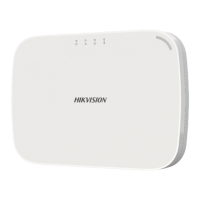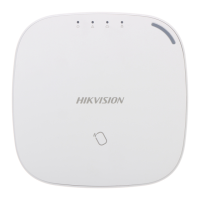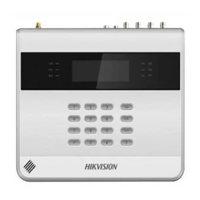Do you have a question about the HIKVISION DS-PHA64-LP/NP and is the answer not in the manual?
| Brand | HIKVISION |
|---|---|
| Model | DS-PHA64-LP/NP |
| Category | Control Panel |
| Language | English |
Provides information about the manual's content, purpose, and usage guidelines.
Details Hikvision's trademarks and logos, and acknowledges other mentioned trademarks.
Outlines limitations of liability, warranties, and user responsibilities for product use.
Explains data collection, storage, processing, and privacy by design principles.
Defines the meaning of symbols used in the document for clarity and safety.
Lists relevant EN standards and details the EU Conformity Statement for the product.
Provides an overview of the AX HYBRID PRO control panel's capabilities and applications.
Step-by-step guide for activating the device using a web browser and SADP software.
Instructions for activating the device and connecting it to Wi-Fi via a mobile app.
Details on connecting to and configuring the device using its web client interface.
Configuration of time settings, including time zone, NTP sync, and DST management.
Setting various authority options like Forced Auto Arm, Forced Arming, and Status Reports.
Configuring automatic arming/disarming schedules, exceptions, and alarm duration.
Enabling and configuring fault detection for network cameras, power, LAN, Wi-Fi, etc.
Setting arming parameters including fault prompts, early alarm, and arming with faults.
Instructions for entering the device enrollment mode for adding peripherals.
Enabling or disabling SSH (Secure Shell) for secure remote access.
Configuring user lockout based on failed login attempts and setting auto-lock duration.
Setting parameters for module locking, including failure attempts and duration.
Managing enrolled peripherals like detectors, sounders, and keypads.
Configuring zone parameters, including type, sensitivity, and linking.
Describes various input zone types like Instant, Delay, Panic, Fire, and Timeout.
Setting arm mode for zones, including 'And', 'Or' logic for linked areas.
Configuring sounder parameters such as name, duration, and linked areas.
Setting keypad parameters, mode, authorization, and arming light.
Setting parameters for keyfobs, including enrollment and button functions.
Configuring tags for arming, disarming, and patrol functions.
Setting parameters for relay outputs, including event types and activation modes.
Adding and configuring network cameras for video monitoring and event video.
Adding cameras and linking them to zones for video monitoring and event video.
Setting video parameters for cameras, including stream type, resolution, and bitrate.
Linking zones to selected areas and configuring basic area settings.
Configuring wired network parameters like IP address, subnet mask, and gateway.
Setting up Wi-Fi connection parameters for secure and credible networks.
Configuring cellular network parameters for alarm notifications via SIM card.
Setting up alarm receiving center parameters and uploading alarm reports.
Configuring SMTP and FTP parameters for sending alarm videos and event notifications.
Enabling and configuring push notifications for various alarm and status events.
Configuring phone call and SMS parameters for alarm notifications.
Registering the device to the mobile client for remote configuration via Hik-Connect.
Configuring email notifications for alarm videos and events.
Configuring FTP server for saving alarm videos and snapshots.
Enabling UPnP function for seamless network connectivity.
Performing device maintenance tasks like upgrade, log search, and testing.
Viewing the status of zones, sounders, automation, keypads, keyfobs, and modules.
Instructions for configuring the AX HYBRID PRO using the Hik-ProConnect mobile client.
Downloading and logging into the Hik-ProConnect mobile client.
Adding the AX HYBRID PRO device to the Hik-ProConnect mobile client.
Adding peripherals to the AX HYBRID PRO system.
Overview of the main page for viewing faults, arming/disarming areas, and device status.
Managing zones, including adding new zones and configuring zone types.
Managing users, including adding, editing, deleting, and assigning permissions.
Managing cards/tags for arming, disarming, and silencing alarms.
Changing device language and selecting the time zone.
Configuring system management options like forced arming and voice prompts.
Performing fault checks for various system components like cameras, power, and network.
Setting arm options, including fault prompts and confirmation processes.
Entering enrollment mode to add peripherals to the system.
Adding and configuring network cameras to the AX HYBRID PRO.
Setting video parameters for cameras, including stream type and bitrate.
Configuring automatic arming and disarming schedules for areas.
Configuring communication parameters for wired network, Wi-Fi, and cellular data.
Setting up push notification parameters for various events.
Configuring alarm receiving center parameters and protocol types.
Selecting communication modes for cloud services like Auto, Wired, and Cellular.
Configuring email notifications for alarm events and setting sender/receiver details.
Configuring FTP settings for preferred or alternated FTP, protocol, and server details.
Performing device maintenance such as rebooting, upgrading, and log collection.
Connecting the AX HYBRID PRO to Wi-Fi through the mobile app.
Receiving and checking alarm notifications from the mobile client.
Setting up ATS in transceiver of receiving center and panel.
Activating a panic alarm and reviewing received messages via Receiver Traffic.
Describes different user access levels for installers, administrators, and operators.
Details on how to arm the system using various methods and detector status checks.
Explains how to disarm the system and the indication signals.
Commands for controlling the security system via SMS for arming, disarming, and silencing.
Troubleshooting common communication issues like IP conflicts and inaccessible web pages.
Resolving issues where the Hik-Connect service appears offline.
Troubleshooting frequent disconnections of network cameras.
Solutions for problems encountered when adding devices via the mobile app.
Diagnosing why alarm information is not received by the app or alarm center.
Addressing issues related to functions that cannot be active simultaneously.
Troubleshooting zone faults such as offline status, tamper, or triggered states.
Resolving issues that prevent the system from arming.
Troubleshooting failures in test mode or alarm clearing operations.
Resolving issues with sending test mails or mails during normal operation.
Details on various input types like Instant, Perimeter, Delayed, Follow, Panic, and Fire zones.
Describes output types for Arming, Disarming, Alarm, Zone Linkage, and Manual Operation.
Table showing event types and their default configurations for different notification methods.
Defines access levels 1, 2, and 3 with descriptions of user roles and permissions.
Table detailing function permissions for each access level (1, 2, and 3).
Details on detecting Alarm Transmission Path (ATP) and Alarm Transmission System (ATS) faults.
Explains the ATS category (DP2) and transmission path selection for alarm reports.
Table mapping SIA codes and CID codes for transmitting security events via DC09 protocol.
Information on user accounts and privacy statement for device access.
Description of user privacy information such as password, username, and logs.











